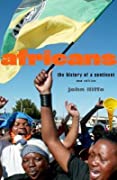Africans by John Iliffe (Book Review)

I am generally a fan of sweeping history narratives so I was willing to give John Iliffe’s
Africans: The History of a Continent a chance. Coming in at a tidy 315 pages plus references, the book was published in 2017 as part of the African Studies Series from Cambridge University Press. Iliffe attempts to cover the continent’s history from the Stone Age to the AIDS epidemic. The book focuses on the big anthropological themes in African history: migration patterns, climate change, agriculture, and trade. The book is relatively light on granular political details and has to, necessarily given its length, paint with a broad brush.
While West, East, and Equatorial Africa all have significantly different histories, the challenge of demography in each region emerges as a consistent theme. As the Europeans found out when they colonized North America, population growth was the key to maintaining and expanding political control. Similarly, indigenous African colonization (especially in West Africa) placed a strong emphasis on maximizing the population from the level of the family to the tribe as a whole. The historic obsession over fertility and population growth helps in part explain the prominence of polygyny and slavery in many areas of Africa. Even in West Africa today, being a woman and infertile is seen as one of the worst fates possible. Ayobami Adebayo’s 2017 best-seller Stay with Me vividly describes the social strain infertility causes in contemporary Nigeria. The fear of infertility is also related the long history of endemic syphilis and gonorrhoea on the continent.
Some 36 percent of Gabonese women whose childbearing years spanned the period 1930-1954 never bore a child, compared with a normal average of about 5 percent. The chief reason was gonorrhoea, exacerbated by such customary male responses to infertility as trial marriage, polygyny, and frequent divorce.
Due to the social and economic pressure for large numbers of offspring, political conflict in Africa has often been within generations rather than between hierarchies, tribes, or religious groups. Youth Groups have been important throughout 20th century African political history and remain a potent force today. The ability of the ANC’s Youth League to divide the party over economic nationalism and racial relations is a case in point. African Coups that were ubiquitous during the Cold War were often the result of the junior officer class rebelling against the inability of their cohort to secure promotions.
The only leisure activity with a history stretching back beyond European contact is the board game often known in West Africa and mankala… Being African, the game was played quickly, publicly, socially, noisily. Islam frowned on it and replaced it by the more sedate dara, a form of draughts, while the Ethiopian nobility either played an especially complicated variant or preferred chess. Chess was the game of a stratified society, with unequal pieces and the objective of destroying the opposing forces. In mankala all pieces were of equal value and the aim was to capture the opposing pieces and add the to one’s own. It was the game of a society dedicated to building up its numbers.
Islam has a long and interesting history in Africa and better understanding its past helps to put into perspective phenomena like Boko Haram, especially in relation to the region’s historic jihadist wars. The Kano Chronicles provides one of West African’s most interesting and detailed lineages of Muslim rulers for close to a thousand years.
As missionaries have long noticed, the converted tend to influence the religion as much as they are influenced by it. Since Islam spread throughout Africa during a period when there was almost no institutional support for literacy, its early culture was primarily oral and eclectic. Though this seems paradoxical given the centrality of the written word of the Koran in Islam, most African kingdoms and rulers that adopted the religion did so for practical reasons. Muslims were often seen as possessing impressive “magic” and many leaders wanted to benefit from being able to claim a genealogical connection with Islam’s sacred history. This period in West African history reminds me of the novel Baudolino by Umberto Eco in which there is a sect of Christian’s in the fabled eastern kingdom of Prestor John who have lost all their copies of the bible and must rely on their memory and rituals to remain devout believers.
Although the Ethiopian church is one of the oldest Christian churches in existence, the religion’s spread occurred mainly during the period of intensive European colonization. I found the case of Khama III of modern Botswana a particularly interesting case study in how political entrepreneurship could be conducted with Christianity during the period.
Among the Ngwato section of the Tswana, the young Khama used his fellow Christians to seize his father’s throne in 1875 and ruled for the next forty-eight years as a model Christian modernizer, fostering trade and education, discouraging indigenous ceremonies, banning imported alcohol and the sale of land, and using missionaries both as ritual experts and as intermediaries to secure British protection against Afrikaner aggression.
There is considerable debate in the anthropological community about the origin and spread of iron metallurgy in Sub-Saharan Africa. While I found most of the nuances uninteresting, it was intriguing to discover that blacksmiths were at the top of the social hierarchy in many societies and were assumed to use magic to carry out there craft. For example the iron workers of Kano have a long and storied past. The city boasted 64 blacksmiths in 1926 and even had 37 in 1971, long after the import of foreign metals. Were Africans to have been allowed a longer length, additional details around African economic history would have been quite interesting. An extended discussion on the United Africa Company, which controlled 50% of all West African trade, would have merited more discussion. The book mentions that the National Bank of Nigeria was the first indigenous bank on the continent. How was it capitalized and what was the state of pre- and post-colonial financial markets? A future African Studies Series book may be able to provide more details.
Another fascinating piece of political history I learned was how jurisdictional competition helped to limit the abuses that African leaders and kings could inflict upon their citizens. In areas where the African population could migrate easily, an abusive leader would often find his vote with their feet. Consider Livingstone’s encounter with the Kazembe kingdom in 1867:
When he usurped power five years ago, his country was densely peopled; but he as so severe in his punishments – cropping the ears, lopping of the hands, and other mutilations, selling the children for very slight offences, that his subjects gradually dispersed themselves in the neighbouring countries beyond his power. This is the common mode by which tyranny is cured in parts like these, where fugitives are never returned. The present Casembe is very poor.
The Kazembe Kingdom may be a useful case study for the modern Charter City movement! Africans can be read by almost any audience from a first year undergraduate to a more seasoned reader. While I found some of the anthropological details uninteresting, the author is clearly writing from his subject area expertise. Overall the book is a useful complement to some of the longer and more tedious continent-wide histories of Africa.
